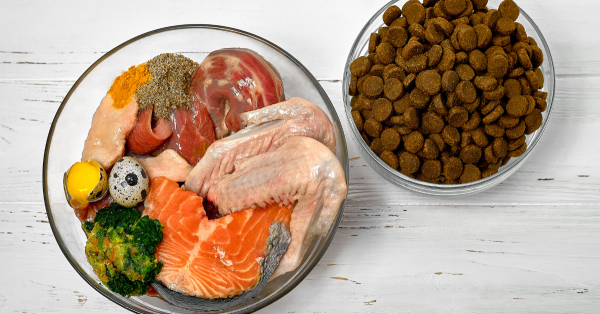
Why Science—Not Scare Tactics—Should Drive Pet Food Messaging
Over the last few years, fresh and frozen pet foods have gained significant popularity, driven by a growing movement among pet parents who want to feed their animals as well as, if not better than, they feed themselves. Some brands have leveraged this perspective and begun to market their products as the only “real food” available.
The implication of this is simple but very influential: if you’re feeding your pets kibble or canned food, you’re not giving them something “real” or “healthy.” While emotionally compelling, these claims overlook an important fact: kibble and canned foods have a long history of safely nourishing millions of pets worldwide.

Photo by Zontica (Getty Images)
Fear-Based Messaging in Marketing
Pet food trends and marketing often reflect those of human food, and the rise of “clean eating” has influenced how companies talk about feeding pets. Unfortunately, this has given rise to fear-based advertising that suggests dry or wet food is little more than “filler” or “junk.” Ads claiming that “your dog deserves better than processed pellets,” “kibble is essentially fast food for pets,” or that canned food provides “poor ingredient quality despite marketing claims” are designed to push consumers toward raw or fresh alternatives. These tactics play on consumers’ guilt. Pet owners naturally want the best for their companions, and claims that kibble isn’t “real food” can spark anxiety that they’re harming their pets.
The reality, however, is more nuanced. When brands undervalue certain product formats, they may attract attention in the short term, but they also risk eroding consumer trust in the long run.
Advertising has a powerful impact on how pet parents perceive their choices. When brands market their products as the only “real food,” they create a false perception in which feeding their product equates to love, health, and authenticity, while feeding another equals neglect or harm. This narrative creates unnecessary guilt for pet parents who only want the best for their companions. Many pet parents who feed traditional kibble or canned food may feel they’re making the wrong choice, even when their pets are thriving.
What Science Actually Says
Decades of research and regulation support the nutritional adequacy of dry and wet foods when properly formulated. Kibble, wet food, fresh, raw, freeze-dried, and other diets all have the potential to meet pets’ dietary needs. No format is inherently superior—what matters most is the quality of the ingredients, the formulation, and whether the diet is complete and balanced. Despite fear-mongering marketing, pet owners can feel confident knowing that multiple options exist to suit different lifestyles, budgets, and pet preferences.

Photo by Shapoval08
The Industry-Wide Impact
When brands attack each other through misleading claims, it affects the entire industry. Instead of establishing pet food as a trusted, science-driven industry, divisive messaging can make consumers doubt all products.
Pet owners faced with these types of ads can feel pressured to buy only premium or boutique products and stretch their budgets unnecessarily, believing that mid-range or traditional diets are “less loving” or “unsafe.” In some cases, owners have even expressed guilt or shame when they cannot afford the most expensive options, which turns feeding into a source of stress instead of care.
These marketing messages also put strain on the veterinarian–client relationship. Veterinarians often recommend science-backed diets, but when owners have been exposed to fear-based advertising, they may question or even distrust their vet’s guidance. This can weaken the collaborative partnership that is essential for good animal care, replacing it with conflict or skepticism.
This erosion of trust has consequences. Pet owners may turn away from established, nutritionally complete diets in favor of unregulated homemade recipes or fad foods. In the worst cases, pets may suffer nutritional deficiencies or health risks due to this misinformation. Fear-based advertising weakens the credibility of the industry as a whole.
Brands don’t have to choose between compelling marketing and responsible communication. There’s a better path forward—one grounded in transparency, education, and evidence. Ultimately, pet parents want to feel confident, not conflicted, about the choices they make. Feeding pets should be an act of care and love—not a source of anxiety manufactured by marketing.
At BSM Partners, we specialize in helping brands bridge the gap between cutting-edge nutrition science and effective marketing. Our team of formulation experts and nutritionists works alongside our marketing strategists to ensure that every product story is rooted in evidence and credibility. Whether developing complete and balanced diets, refining formulations, or crafting science-backed messaging, BSM helps brands build trust with consumers while standing out in a competitive marketplace.
Follow us on LinkedIn for the latest updates on all things happening here at BSM Partners.
About the Author
Ada-Miette Thomas is a senior analyst at BSM Partners. She received both bachelor’s and master’s degrees in food science with an emphasis on nutrition. Ada-Miette conducted research with a focus on human nutrition and studied the effects of carbohydrate sources on markers of Metabolic Syndrome in adults.
This content is the property of BSM Partners. Reproduction or retransmission or repurposing of any portion of this content is expressly prohibited without the approval of BSM Partners and is governed by the terms and conditions explained here.